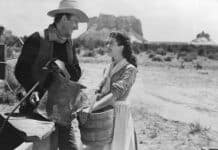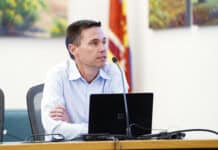Sedona City Council granted Sathcupa’s plan amendment request Wednesday night, Nov. 29, but not before amending the resolution to place some restrictions on the property.
Larson Newspapers
________________
Sedona City Council granted Sathcupa’s plan amendment request Wednesday night, Nov. 29, but not before amending the resolution to place some restrictions on the property.
The designation change on the Community Plan Future Land Use Map from “public
/semi-public” to “planned area” was unanimously approved by council on Wednesday.
Both city staff and the Planning and Zoning Commission had recommended denial of the amendment proposal.
The original development plan submitted by Fitch Industries — who is in escrow with Sathcupa for the land — was not possible under “public/semi-public” designation due to the addition of commercial and lodging.
This change will effect only 23 acres of the original 44-acre cultural park. The other portion will be considered at a later date.
Council agreed on Wednesday to pass the amendment, but the non-arts-related commercial development needed to be limited and plans to build lodging must wait.
Fitch Industries President Kent Fitch told council that the commercial aspect was necessary to make the project viable.
Council agreed, but imposed boundaries.
“I agree there has to be more commercial,” Mayor Pud Colquitt said. “The problem is how much.”
Council revised the amendment resolution to limit the building area of non-arts-related commercial to a maximum of 40,000 square feet of the approved 160,000 square foot building area.
According to the city code, “public/semi-public” designation allowed for some limited commercial — such as small eateries — but Fitch said that wasn’t enough.
“This has to be more commercial or it’s going to be nothing,” Fitch said.
Lodging was an issue for many council members because it was added very late in the process, not allowing for much public notification.
There was only one public meeting after Fitch Industries took over the proposal
and completely changed the amendment proposal.
Councilmen Rob Adams, Harvey Stearn, John Bradshaw and Ramon Gomez were willing to include lodging in the resolution despite their concerns about the notification process.
All said they were concerned about the lack of public input on this component, but they were willing to go ahead with it for the sake of the project.
“Opportunities seldom come in nice, neat, conforming packages,” Stearn said.
Stearn said he didn’t feel the lodging issue should prevent the development from eventually being built.
“You don’t just say, ‘I think we’ll wait a year to be safe,’” Stearn said.
Gomez agreed that opportunities needs to be recognized as they arise and that the positives outweighed the negatives in this case.
“It’s always a challenge when you balance out fear, risk and opportunity,” Gomez said.
Adams said this project gives Sedona the chance to truly be a city animated by the arts and that he felt the community would accept lodging to make this happen.
The appearance that the public wasn’t given the proper opportunity to comment concerned Bradshaw — who said he’s serious about public opinion — but he still agreed with Stearn and Adams.
Support from four of the seven council members wouldn’t have been enough to pass the resolution.
To pass a plan amendment it must receive a two-thirds majority vote — meaning support from five council members.
Councilwoman Nancy Scagnelli said she liked the project but that didn’t mean the public would agree.
“[What] I have a problem with is that the community really doesn’t know what’s going on,” Vice Mayor Jerry Frey said.
Frey said he wasn’t be able to support lodging at the time of the vote.
“I have two very big hurdles that I don’t know if I can get over,” Colquitt said.
She felt the process had been lost over the past months and that public input is a vital part of that.
Without public input, she said she wouldn’t be able to support lodging. Second, she still wasn’t comfortable splitting the original 44-acre park into two phases.
Council was eventually able to find common ground with revisions to the resolution and gave Fitch Industries the go-ahead to move into the rezoning process.


















